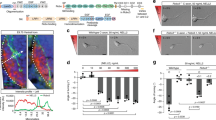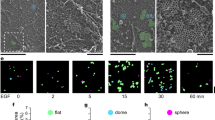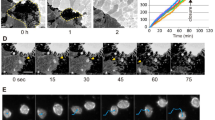Abstract
The formation of axon trajectories requires integration of local adhesive interactions with directional information from attractive and repulsive cues. Here, we show that these two types of information are functionally integrated; activation of the transmembrane receptor Roundabout (Robo) by its ligand, the secreted repulsive guidance cue Slit, inactivates N-cadherin-mediated adhesion. Loss of N-cadherin-mediated adhesion is accompanied by tyrosine phosphorylation of β-catenin and its loss from the N-cadherin complex, concomitant with the formation of a supramolecular complex containing Robo, Abelson (Abl) kinase and N-cadherin. Local formation of such a receptor complex is an ideal mechanism to steer the growth cone while still allowing adhesion and growth in other directions.
This is a preview of subscription content, access via your institution
Access options
Subscribe to this journal
Receive 12 print issues and online access
$209.00 per year
only $17.42 per issue
Buy this article
- Purchase on Springer Link
- Instant access to full article PDF
Prices may be subject to local taxes which are calculated during checkout








Similar content being viewed by others
References
Yu, T. W. & Bargmann, C. I. Dynamic regulation of axon guidance. Nature Neurosci. Suppl. 4, 1169–1176 (2001).
Tepass, U., Truong, K., Godt D., Ikura, M. & Peifer, M. Cadherins in embryonic and neural morphogenesis. Nature Rev. Mol. Cell Biol. 1, 91–100 (2000).
Redies, C. Cadherins in the central nervous system. Prog. Neurobiol. 61, 611–648 (2000).
Ranscht, B. Cadherins: molecular codes for axon guidance and synapse formation. Int. J. Develop. Neurosci. 18, 643–651 (2000).
Bixby, J. L. & Zhang, R. Purified N-cadherin is a potent substrate for the rapid induction of neurite outgrowth. J. Cell Biol. 110, 1253–1260 (1990).
Bixby, J. L., Lilien, J. & Reichardt, L. F. Identification of the major proteins that promote neuronal process outgrowth on Schwann cells in vitro. J. Cell Biol. 107, 353–361 (1988).
Neugebauer, K. M., Tomaselli, K. J., Lilien, J. & Reichardt, L. F. N-cadherin, NCAM, and integrins promote retinal neurite outgrowth on astrocytes in vitro. J. Cell Biol. 107, 1117–1187 (1988).
Tomaselli, K. J., Neugebauer, K. M., Bixby, J. L., Lilien, J. & Reichardt, L. F. N-cadherin and integrin: Two receptor systems that mediated neuronal process outgrowth on astrocyte surfaces. Neuron 1, 33–43 (1988).
Matsunaga, M., Hatta, K., Nagafuchi, A. & Takeichi, M. Guidance of optic nerve fibres by N-cadherin adhesion molecules. Nature 334, 62–64 (1988).
Iwai, Y. et al. Axon patterning requires DN-cadherin, a novel neuronal adhesion receptor, in the Drosophila embryonic CNS. Neuron 19, 77–89 (1997).
Wheelock, M. J., Knudsen, K. A. & Johnson, K. R. Membrane–cytoskeleton interactions with cadherin cell adhesion proteins: roles of catenins as linker proteins. Curr. Top. Mem. 43, 169–185 (1996).
Kidd, T. et al. Roundabout controls axon crossing of the CNS midline and defines a novel subfamily of evolutionarily conserved guidance receptors. Cell 92, 205–215 (1998).
Brose, K. et al. Slit proteins bind Robo receptors and have an evolutionarily conserved role in repulsive axon guidance. Cell 96, 795–806 (1999).
Holmes, G. P. et al. Distinct but overlapping expression patterns of two vertebrate slit homologues implies functional roles in CNS development and organogenesis. Mech. Dev. 79, 57–72 (1998).
Bagri, A. et al. Slit proteins prevent midline crossing and determine the dorsoventral position of major axonal pathways in the mammalian forebrain. Neuron 33, 233–248 (2002).
Erskine, L. et al. Retinal ganglion cell axon guidance in the mouse optic chiasm: expression and function of Robos and Slits. J. Neurosci. 20, 4975–4982 (2000).
Niclou, S. P., Jia, L. & Raper, J. A. Slit2 is a repellent for retinal ganglion cell axons. J. Neurosci. 20, 4962–4974 (2000).
Ringstedt, T. et al. Slit inhibition of retinal axon growth and its role in retinal axon pathfinding and innervation patterns in the Diencephalon. J. Neurosci. 20, 4983–4991 (2000).
Seeger, M., Tear, G., Ferres-Marco, D. & Goodman, C. S. Mutations affecting growth cone guidance in Drosophila: genes necessary for guidance toward or away from the midline. Neuron 10, 409–426 (1993).
Kidd, T., Bland, K. S. & Goodman, C. S. Slit is the midline repellent for the Robo receptor in Drosophila. Cell 96, 785–794 (1999).
Rajagopalan, S., Nicolas, E., Vivancos, V., Berger, J. & Dickson, B. J. Crossing the midline: roles and regulation of Robo receptors. Neuron 28, 767–777 (2000).
Murray, M. J. & Whitington, P. M. Effects of roundabout on growth cone dynamics, filopodial length, and growth cone morphology at the midline and throughout the neuropile. J. Neurosci. 19, 7901–7912 (1999).
Lilien, J., Balsamo, J., Arregui, C. & Xu, G. Turn-off, drop-out: functional state switching of cadherins. Develop. Dyn. 224, 18–29 (2002).
Rothberg, J. M., Jacobs, J. R., Goodman, C. S. & Artavanis-Tsakonas, S. Slit: an extracellular protein necessary for development of midline glia and commissural axon pathways contains both EGF and LRR domains. Genes Dev. 4, 2169–2187 (1990).
Bashaw G. J. & Goodman, C. S. Chimeric axon guidance receptors: the cytoplasmic domains of slit and netrin receptors specify attraction versus repulsion. Cell 97, 917–926 (1999).
Stein, E. & Tessier-Lavigne, M. Hierarchical organization of guidance receptors: Silencing of netrin attraction by Slit through a Robo–DCC receptor complex. Science 291, 1928–1938 (2001).
Grunwald, G. B. Cadherin cell adhesion molecules in retinal development and pathology. Prog. Retinal Eye Res. 15, 363–392 (1996).
Gaya-Gonzalez, L., Balsamo, J., Swaminathan, N. & Lilien, J. Antibodies to the retina N-Acetylgalactosaminylphosphotransferase inhibit neurite outgrowth. J. Neurosci. Res. 29, 474–480 (1991).
Lambert, M., Padilla, F. & Mege, R. M. Immobilized dimers of N-cadherin–Fc chimera mimic cadherin-mediated cell contact formation: contribution of both outside-in and inside-out signals. J. Cell Sci. 113, 2207–2219 (2000).
Balsamo, J., Thiboldeaux, R., Swaminathan, N. & Lilien, J. Antibodies to the retina N-acetylgalactosaminylphosphotransferase modulate N-cadherin-mediated adhesion and uncouple the N-cadherin transferase complex from the actin-containing cytoskeleton. J. Cell Biol. 113, 429–436 (1991).
Roura, S., Miravet, S., Piedra, J., de Herreros, A. G. & Duñach, M. Regulation of E-cadherin–catenin association by tyrosine phosphorylation. J. Biol. Chem. 274, 36734–36740 (1999).
Piedra, J. et al. Regulation of β-catenin structure and activity by tyrosine phosphorylation. J. Biol. Chem. 276, 20436–20443 (2001).
Van Etten, R. A. Cycling, stressed-out and nervous: cellular functions of c-Abl. Trends Cell Biol. 9, 179–186 (1999).
Bashaw, G. J., Kidd, T., Murray, D., Pawson, T. & Goodman, C. S. Repulsive axon guidance: Abelson and Enabled play opposing roles downstream of the roundabout receptor. Cell 101, 703–715 (2000).
Derossi, D., Chassaing, G. & Prochiantz, A. Trojan peptides: the penetratin system for intracellular delivery. Trends Cell Biol. 8, 84–87 (1998).
Arregui, C., Pathre, P., Lilien, J. & Balsamo, J. The nonreceptor tyrosine kinase Fer mediates cross-talk between N-cadherin and β1-integrins. J. Cell Biol. 149, 1263–1274 (2000).
Sun, X., Layton, J. E., Elefanty, A. & Lieschke, G. J. Comparison of effects of the tyrosine kinase inhibitors AG957, AG490, and STI571 on BCR-ABL-expressing cells, demonstrating synergy between AG490 and STI571. Blood 97, 2008–2015 (2001).
Lu, Q. et al. Brain Armadillo protein δ-catenin interacts with Abl tyrosine kinase and modulates cellular morphogenesis in response to growth factors. J. Neurosci. Res. 67, 618–624 (2002).
Li, H., Leung, T.-C., Hoffman, S., Balsamo, J. & Lilien, J. Coordinate regulation of cadherin and integrin function by the chondroitin sulfate proteoglycan neurocan. J. Cell Biol. 149, 1275–1288 (2000).
Oohira, A., Matsui, F., Watanabe, E., Kushima, Y. & Maeda, N. Developmentally regulated expression of a brain specific species of chondroitin sulfate proteoglycan, neurocan, identified with a monoclonal antibody IG2 in the rat cerebrum. Neurosci. 60, 145–157 (1994).
Wong, K. et al. Signal transduction in neuronal migration: roles of GTPase activating proteins and the small GTPase cdc42 in the Slit–Robo pathway. Cell 107, 209–221 (2001).
Bashaw, G. J., Hu, H., Nobes, C. D. & Goodman, C. S. A novel Dbl family RhoGEF promotes Rho-dependent axon attraction to the central nervous system midline in Drosophila and overcomes Robo repulsion. J. Cell Biol. 155, 1117–1122 (2001).
Fritz, J. L. & VanBerkum, M. F. Calmodulin and son of sevenless dependent signaling pathways regulate midline crossing of axons in the Drosophila CNS. Development 127, 1991–2000 (2000).
Lanier, L. M. & Getler, F. B. From Abl to actin: Abl tyrosine kinase and associated proteins in growth cone motility. Curr. Opin. Neurobiol. 10, 80–87 (2000).
Riehl, R. et al. Cadherin function is required for axon outgrowth in retinal ganglion cells in vivo. Neuron 17, 837–848 (1996).
Plump, A. S. et al. Slit1 and Slit2 cooperate to prevent premature midline crossing of retinal axons in the mouse visual system. Neuron 33, 219–232 (2002).
Fricke, C., Lee, J.-S., Geiger-Rudolph, S., Bonhoeffer, F. & Chien, C.-B. Astray, a Zebrafish roundabout homolog required for retinal axon guidance. Science 292, 507–510 (2001).
Hutson, L. D. & Chien, C.-B. Pathfinding and error correction by retinal axons: the role of astray/robo2. Neuron 33, 205–217 (2002).
Loureiro, J. & Peifer, M. Roles of Armadillo, a Drosophila catenin, during central nervous system development. Curr. Biol. 8, 622–632 (1998).
Grevengoed, E. E., Loureiro, J. J., Jesse, T. L. & Peifer, M. Abelson kinase regulates epithelial morphogenesis in Drosophila. J. Cell Biol. 155, 1185–1198 (2001).
Acknowledgements
We thank C. Goodman and M. Seeger for antibody and cDNA reagents and K. Campbell, D. Eberl and C.-F. Wu for careful reading of the manuscript. This work was supported by grants from the National Eye Institute (J.L. and J.B.) and the National Science Foundation (M.V.B.).
Author information
Authors and Affiliations
Corresponding author
Ethics declarations
Competing interests
The authors declare no competing financial interests.
Rights and permissions
About this article
Cite this article
Rhee, J., Mahfooz, N., Arregui, C. et al. Activation of the repulsive receptor Roundabout inhibits N-cadherin-mediated cell adhesion. Nat Cell Biol 4, 798–805 (2002). https://doi.org/10.1038/ncb858
Received:
Revised:
Accepted:
Published:
Issue Date:
DOI: https://doi.org/10.1038/ncb858
This article is cited by
-
Vascular control of the Drosophila haematopoietic microenvironment by Slit/Robo signalling
Nature Communications (2016)
-
Stromal SLIT2 impacts on pancreatic cancer-associated neural remodeling
Cell Death & Disease (2015)
-
A gene signature of bone metastatic colonization sensitizes for tumor-induced osteolysis and predicts survival in lung cancer
Oncogene (2014)
-
The expression and activity of β-catenin in the thalamus and its projections to the cerebral cortex in the mouse embryo
BMC Neuroscience (2012)
-
Autocrine/juxtaparacrine regulation of axon fasciculation by Slit-Robo signaling
Nature Neuroscience (2012)



